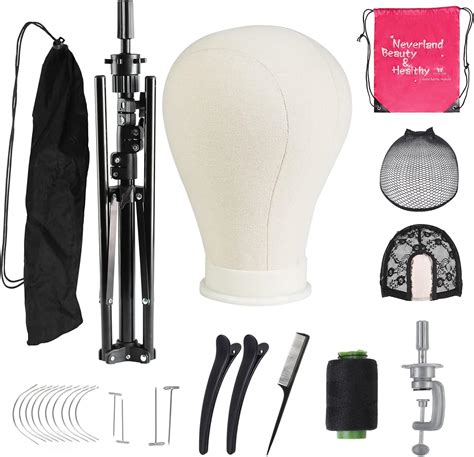Introduction
In the realm of hairstyling and cosmetology, a wig head stand is an indispensable tool. It allows stylists, hairdressers, and wig enthusiasts to work with wigs efficiently and effectively, creating stunning looks that enhance their clients’ confidence and self-expression. This comprehensive guide delves into the world of wig head stands, empowering you to make informed decisions about their selection, maintenance, and groundbreaking applications.

Choosing the Right Wig Head Stand
Selecting the ideal wig head stand is crucial for a seamless wig-styling experience. Consider these key factors:
Materials:
- Canvas: Soft and durable, suitable for delicate wigs and precision styling.
- Plastic: Affordable and durable, recommended for everyday use.
- Metal: Sturdy and long-lasting, ideal for heavy wigs and displaying elaborate hairstyles.
Height Adjustability:
- Adjustable stands allow you to customize the height for comfortable working.
- Consider the height of the hairstyles you’ll be creating and your own height.
Base Type:
- Tripod: Stable and portable, suitable for various workspaces.
- Tabletop: Compact and convenient, ideal for smaller work areas.
- Clamps: Attach directly to a table or counter, providing maximum stability.
Head Shape:
- Oval: Mimics the human head shape for accurate styling.
- Flat: Ideal for displaying wigs without creating volume.
- Cone-shaped: Suitable for styling wigs with volumized crowns.
Additional Features:
- Shoulder brackets: Support wigs with long hair or elaborate updos.
- Surrounding stand rods: Allow for quick and easy wig placement and removal.
- Carrying case: Protects your stand during storage and transportation.
Maintaining Your Wig Head Stand
Proper care extends the lifespan and performance of your wig head stand. Follow these simple steps:
- Clean regularly: Use a soft cloth dampened with a mild soap solution.
- Dry thoroughly: Avoid using heat sources or direct sunlight, as it can damage the materials.
- Tighten bolts and screws: Ensure all components are secure for optimal stability.
- Store properly: Keep the stand in a dry, cool place when not in use to prevent damage.
Amplifying Your Wig Head Stand’s Potential
Beyond wig styling, wig head stands unleash a myriad of creative possibilities:
- Hat display: Showcase hats, headpieces, and hair accessories in a professional manner.
- Photography prop: Capture stunning images of wigs and hairstyles without the need for a model.
- Educational tool: Use the stand to demonstrate hairdressing techniques, color theories, and styling tips.
- Fashion design: Experiment with different wig textures, colors, and lengths to inspire fashion designs.
Useful Tables
Table 1: Materials and Their Suitability
| Material | Suitability |
|—|—|—|
| Canvas | Delicate wigs, precision styling |
| Plastic | Everyday use, budget-friendly |
| Metal | Heavy wigs, displaying elaborate hairstyles |
Table 2: Base Types and Use Cases
| Base Type | Use Cases |
|—|—|—|
| Tripod | Stable and portable, various workspaces |
| Tabletop | Compact and convenient, smaller work areas |
| Clamps | Maximum stability, table or counter attachment |
Table 3: Head Shapes and Styling Applications
| Head Shape | Styling Applications |
|—|—|—|
| Oval | Accurate styling, mimicking human head |
| Flat | Wig display, no added volume |
| Cone-shaped | Volumized crowns, elaborate updos |
Table 4: Creative Applications of Wig Head Stands
| Application | Benefits |
|—|—|—|
| Hat display | Professional showcasing, headpieces, hair accessories |
| Photography prop | Stunning images, no model required |
| Educational tool | Hairdressing techniques, color theories, styling tips |
| Fashion design | Inspiration for wig textures, colors, lengths |
Common Mistakes to Avoid
- Overtightening bolts and screws can damage the stand.
- Using harsh cleaning agents or abrasives can deteriorate the materials.
- Exposing the stand to extreme heat or direct sunlight can weaken its structure.
- Selecting an inappropriate base type for the intended workspace can compromise stability.
- Choosing a head shape that doesn’t align with the desired styling goals can limit creativity.
Pros and Cons of Wig Head Stands
Pros:
- Enhanced wig styling efficiency
- Convenience and portability
- Visual representation of hairstyles
- Versatility for multiple applications
- Affordable investment
Cons:
- Requires proper maintenance
- Can take up workspace when not in use
- Limited adjustability of some models
- Potential for damage if not handled with care
- Can add weight when carrying heavy wigs
FAQs
1. How often should I clean my wig head stand?
Aim to clean your stand after every use, or at least monthly, to maintain its hygiene and performance.
2. Can I use any cleaning agent to wash my wig head stand?
Gentle soap solutions are recommended. Avoid harsh chemicals or abrasives that could damage the materials.
3. What is the ideal height for a wig head stand?
The ideal height allows you to work comfortably without straining your neck or back. Adjust the stand accordingly.
4. How do I transport my wig head stand safely?
Use a carrying case or wrap the stand securely in protective materials during transportation to prevent damage.
5. Can I dye wigs on a wig head stand?
Yes, wig head stands are suitable for dyeing wigs. However, ensure the stand is clean and well-ventilated during the process.
6. How do I store wigs on a wig head stand?
Place the wig on the stand, cover it with a hairnet or plastic bag, and store it in a cool, dry place to maintain its shape and prevent dust buildup.
Conclusion
Embracing a wig head stand empowers hairstylists, wig enthusiasts, and creatives to elevate their craft and explore new frontiers. By selecting, maintaining, and utilizing wig head stands effectively, you unlock countless possibilities to create stunning looks, enhance your skills, and unleash your imagination. Invest in a quality wig head stand today and set the stage for hairdressing brilliance.
